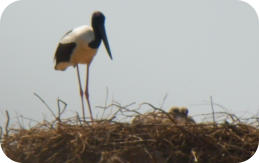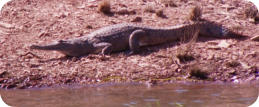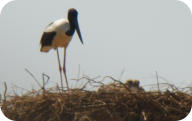
Lake Argyle
A Day At Lake Argyle
6.00
Got up - this is now our habitual rising hour! Showered and ready for the day.
Leisurely breakfast. Watching a small tour group packing up and leaving. Down to the shop area as we are booked on a boat tour for 9am.
12.15
Back from boat tour with Jeff, a former TAFE teacher for the Triple J Boat tour. We would have preferred the local man who did a tour in a
smaller boat, but he wasn't taking morning tours that day.
Jeff did a great job. The tour wasn't what I expected. Lake is huge and covers about 50x60 kms winding through narrow gorges with larger
open waters in the valleys between eroded fold hills. Lots of smack 'peak' islands.
Not a lot of wild life. Some rock wallabies, dingoes that were not visible, very few water birds nesting or feeding. The extra large wet meant
they were nesting at their more traditional sites on lush lagoons with plenty of food around. Despite
a certain stark beauty, Lake Argyle is barren. It still has an unnatural look about it 60 years after its
creation. The steep rocky hill sides drop into the water with practically no vegetation on the
waterside slopes and mostly none in the water probably because the drop-off is too steep and there
is no seed bank of rushes or water weeds yet. A few places are developing some water weeds. Jeff
said about 30,000 freshwater Johnson River crocodiles are the most common wild life. Lots of
Baramundi were previously were heavily fished and sold. This no longer happens as the fish don't
travel well and when fished in fresh water are an unattractive flesh color. They migrate to the ocean
where they develop a firm white flesh that customers prefer.
Saw one nesting pair of large Jabiru storks with two hatched chicks. Jeff said they had nested on an
island in the lake for many years but the last wet swept their nest away. They have built a new nest
on a headland this year. Reputedly they are large enough to scare away dingoes and crocodiles. I
doubt this and suspect they should return to a small island site where at least the dingoes will not
get them. Their stick nest is huge and built on the rocks.
Meg was tired after the boat trip. She also ate too many home-made cookies and fruit cake for
morning tea. Must have been craving some sweet treats after four weeks of enforced light meals.
Colors of the Kimberly/Lake Argyle area differ from the CSR. All distance hills are soft grey/pinks with cool pink/purple shadows. All are
2tone not 3tone. Forground hills are a deep rich red/brown- very warm color. Greens vary but include all from sap green to a strong bright
mid/dark green - not quite viridian. The red dust in the air gives the L/S a haze and contributes to the pronounced fall off in color and tone
of the distant hill features.
Lake Argyle has a somewhat weird L/S when I look more closely at it. I'm looking forward to 'recreating' it at home. Terry took lots of
photos. I did no photos or sketches of it, just soaked it up; the oddness of it and its majesty. Want to incorporate the Jabiru in it somehow;
aloof and alone and in danger.
It's the great place of the 21st century in WA. It’s all going to happen here over the next 100 years. Kimberley has this huge unused water
resource of renewable water at its heart. There will be a use for it as the population, industry and agriculture moves there. After returning
home The federal Liberal Party announced they intended to develop a network of big dams across the top end and focus development here.
A good idea but likely to draw lots of opposition from environmentalists who want to close down growth and development and keep this
area unused for wild life. We may have held this view ourselves a few decades ago, but it appears less likely that Australia can stay small at
less than 30 million population. The East coast is over developed and has run out of water for further expansion. There is already bickering
over water entitlements with pressure on to conserve water. The west and north has to become the growth area with monsoon water
available and huge tracts of land.
4.00
Meg went out and sketched the folded hills about 4km on the entry side of Lake Argyle village.
Wed 17th August



Lake Argyle
A Day At Lake Argyle
6.00
Got up - this is now our habitual rising hour! Showered and ready
for the day.
Leisurely breakfast. Watching a small tour group packing up and
leaving. Down to the shop area as we are booked on a boat tour for
9am.
12.15
Back from boat tour with Jeff, a former TAFE teacher for the Triple J
Boat tour. We would have preferred the local man who did a tour in
a smaller boat, but he wasn't taking morning tours that day.
Jeff did a great job. The tour wasn't what I expected. Lake is huge
and covers about 50x60 kms winding through narrow gorges with
larger open waters in the valleys between eroded fold hills. Lots of
smack 'peak' islands.
Not a lot of wild life. Some rock
wallabies, dingoes that were
not visible, very few water
birds nesting or feeding. The
extra large wet meant they
were nesting at their more
traditional sites on lush lagoons with plenty of food around. Despite
a certain stark beauty, Lake Argyle is barren. It still has an
unnatural look about it 60 years after its creation. The steep rocky
hill sides drop into the water with practically no vegetation on the
waterside slopes and mostly none in the water probably because
the drop-off is too steep and there is no seed bank of rushes or
water weeds yet. A few places are developing some water weeds.
Jeff said about 30,000 freshwater Johnson River crocodiles are the
most common wild life. Lots of Baramundi were previously were
heavily fished and sold. This no longer happens as the fish don't
travel well and when fished in fresh water are an unattractive flesh
color. They migrate to the ocean where they develop a firm white
flesh that customers prefer.
Saw one nesting pair of large Jabiru
storks with two hatched chicks. Jeff
said they had nested on an island in
the lake for many years but the last
wet swept their nest away. They
have built a new nest on a headland
this year. Reputedly they are large
enough to scare away dingoes and
crocodiles. I doubt this and suspect they should return to a small
island site where at least the dingoes will not get them. Their stick
nest is huge and built on the rocks.
Meg was tired after the boat trip. She also ate too many home-
made cookies and fruit cake for morning tea. Must have been
craving some sweet treats after four weeks of enforced light meals.
Colors of the Kimberly/Lake Argyle area differ from the CSR. All
distance hills are soft grey/pinks with cool pink/purple shadows. All
are 2tone not 3tone. Forground hills are a deep rich red/brown-
very warm color. Greens vary but include all from sap green to a
strong bright mid/dark green - not quite viridian. The red dust in
the air gives the L/S a haze and contributes to the pronounced fall
off in color and tone of the distant hill features.
Lake Argyle has a somewhat weird L/S when I look more closely at
it. I'm looking forward to 'recreating' it at home. Terry took lots of
photos. I did no photos or sketches of it, just soaked it up; the
oddness of it and its majesty. Want to incorporate the Jabiru in it
somehow; aloof and alone and in danger.
It's the great place of the 21st century in WA. It’s all going to
happen here over the next 100 years. Kimberley has this huge
unused water resource of renewable water at its heart. There will be
a use for it as the population, industry and agriculture moves there.
After returning home The federal Liberal Party announced they
intended to develop a network of big dams across the top end and
focus development here. A good idea but likely to draw lots of
opposition from environmentalists who want to close down growth
and development and keep this area unused for wild life. We may
have held this view ourselves a few decades ago, but it appears less
likely that Australia can stay small at less than 30 million
population. The East coast is over developed and has run out of
water for further expansion. There is already bickering over water
entitlements with pressure on to conserve water. The west and
north has to become the growth area with monsoon water available
and huge tracts of land.
4.00
Meg went out and sketched the folded hills about 4km on the entry
side of Lake Argyle village.


































